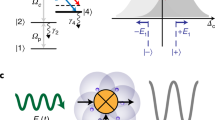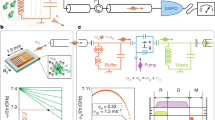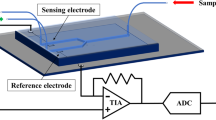Abstract
WE report here preliminary results of an investigation designed to detect the electron spin resonance (e.s.r.) spectrum of radical ions in the vicinity of an electrode surface, with a view to the study of surface phenomena in electrode processes. The application of e.s.r. spectroscopy to electrochemical problems has been confined to the identification of rather stable radical intermediates1 and to the study of their decay processes2. Even when the radical-generating electrode has been placed in the microwave cavity the spectrum produced is indistinguishable from that of the bulk species. Close to the surface of a metallic electrode, however, appreciable differences in ionic concentrations from those in the bulk occur as a result of the electric field at the metal surface3. In addition, specific absorption of solution species at an electrode can occur3, dependent on the electrode potential, and it is known that adsorbed radicals on catalyst surfaces display e.s.r. spectra different from solution spectra of the same species4. Apparent lack of surface phenomena in the e.s.r. spectra of electrochemical systems has been attributed to the great broadening of spectra of surface species possibly by electron exchange or relaxation with the many levels available in the metal. Several workers, however, have noted an apparently greater stability of the radicals when the generating electrode is in the microwave cavity. In order to investigate whether a surface component is present it is necessary to use a stable radical and to be able to distinguish species nearer the electrode from the species diffused into the bulk. To do this we have used an in situ electrode, which has a potential modulated about the redox potential of the radical-parent molecule system so that radicals are alternately formed and destroyed (concentration modulation). The spectrometer output is phase sensitively detected at the modulation frequency. Because the in-phase concentration changes are greatest near the electrode surface, the contribution of radicals close to the electrode predominates in the detected signal at sufficiently high modulation frequencies.
This is a preview of subscription content, access via your institution
Access options
Subscribe to this journal
Receive 51 print issues and online access
$199.00 per year
only $3.90 per issue
Buy this article
- Purchase on Springer Link
- Instant access to full article PDF
Prices may be subject to local taxes which are calculated during checkout
Similar content being viewed by others
References
Adams, R. N., J. Electroanal. Chem., 8, 15 (1964).
Gerischer, H., and Koopman, R., Ber. der Bunsen., 70, 118 (1966).
Mohilner, D. H., Electroanalytical Chemistry (edit. by Bard, A. J.), 1, 241 (Debber, New York, 1966).
Adrian, F. J., J. Colloid Interface Sci., 26, 317 (1968).
Galus, Z., Lee, H. K., and Adams, R. N., J. Electroanal. Chem., 5, 17 (1963).
Author information
Authors and Affiliations
Rights and permissions
About this article
Cite this article
COLLIER, R., PEOVER, M. Synchronous Detection by Electron Spin Resonance of Free-Radicals produced at Potential–Modulated Electrodes. Nature 220, 155–157 (1968). https://doi.org/10.1038/220155a0
Received:
Issue Date:
DOI: https://doi.org/10.1038/220155a0
Comments
By submitting a comment you agree to abide by our Terms and Community Guidelines. If you find something abusive or that does not comply with our terms or guidelines please flag it as inappropriate.



